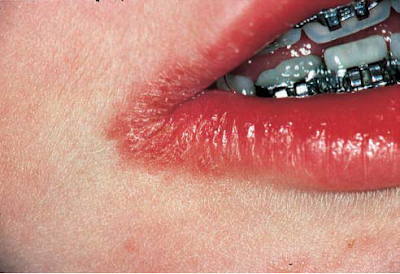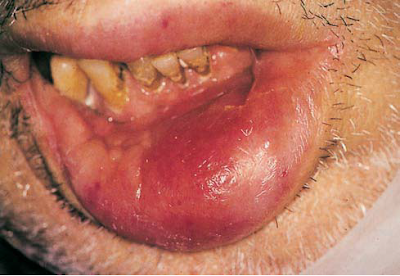Disorders that exclusively affect the lips, systemic diseases that produce characteristic lip lesions, and some other entities are included in this group. In some of them, the diagnosis should be made on the basis of clinical criteria, but histopathological confirmation of the diagnosis is always necessary.
O Cheilitis glandularis
O Cheilitis granulomatosa
O Melkersson–Rosenthal syndrome
O Exfoliative cheilitis
O Contact cheilitis
O Actinic cheilitis
O Angular cheilitis
O Lip-licking dermatitis
O Median lip fissure
O Angioneurotic edema
O Lymphedema due to radiation
O Systemic diseases (Crohn disease, sarcoidosis, tuberculosis, cystic fibrosis)
Cheilitis Glandularis
Definition
Cheilitis glandularis is an uncommon chronic inflammatory condition of the minor salivary glands, characteristically affecting the lower lip.
Etiology
Unknown.
Clinical features
It presents as a swelling of the lower lip due to hyperplasia and inflammation of the glands. Characteristically, the orifices of the salivary glands are dilated, and pressure on the lip may produce mucous or mucopustular fluid from the ductal openings. Crusting and erosions may also occur.
Laboratory tests
Histopathological examination.
Differential diagnosis
Cheilitis granulomatosa, Melkersson–Rosenthal syndrome, Crohn disease, sarcoidosis, cystic fibrosis.
Treatment
Supportive. Vermilionectomy only in severe cases.
 |
| Chelitis Glandularis |
Cheilitis Granulomatosa
Definition
Cheilitis granulomatosa is a rare chronic disorder of the lips.
Etiology
Unknown.
Clinical features
It presents as a painless, persistent, and diffuse swelling of one or both lips. Small vesicles, erosions, and scaling may occur. It is thought that cheilitis granulomatosa is a monosymptomatic form of Melkersson–Rosenthal syndrome.
Laboratory tests
Histopathological examination.
Differential diagnosis
Cheilitis glandularis, Crohn disease, sarcoidosis, cystic fibrosis, lymphangioma, angioneurotic edema.
Treatment
Topical or systemic steroids, tetracyclines. Plastic surgery in severe cases.
 |
| Cheilitis Granulomatosa |
Melkersson–Rosenthal Syndrome
Melkersson–Rosenthal syndrome is a rare disorder characterized by cheilitis granulomatosa, facial paralysis, fissured tongue, and less often intraoral and facial edema. The term “orofacial granulomatosis” has recently been proposed to include conditions and diseases characterized by granulomatous inflammation in the oral and facial area (cheilitis granulomatosa, Melkersson–Rosenthal syndrome, Crohn disease, sarcoidosis). The differential diagnosis and treatment are identical to those of cheilitis granulomatosa.
 |
| Melkersson-Rosenthal Syndrome |
Exfoliative Cheilitis
Definition
Exfoliative cheilitis is a chronic inflammatory disorder of the lips.
Etiology
Unknown.
Clinical features
It is characterized by scaling, crusting, and erythema of the vermilion border of the lips. This pattern is repetitive, resulting in yellowish, hyperkeratotic thickening, crusting, and fissuring (Fig. 342). The lesions are more common in young women, usually persist with variable severity for months or years, and may cause cosmetic problems. The diagnosis is based on the clinical findings.
Differential diagnosis
Contact cheilitis, actinic cheilitis.
Treatment
Symptomatic. Topical moistening agents and steroids may be helpful. Topical ointment of tacrolimus 0.1% may be helpful.
 | |
| Exfoliative chelitis |
Contact Cheilitis
Definition
Contact cheilitis is an acute inflammatory disorder of the lips.
Etiology
Topical contact with various chemical agents.
Clinical features
It is characterized by mild edema and erythema, followed by irritation and thick scaling . It is usually confined to the vermilion border of both lips. The diagnosis is based on clinical criteria and a skin patch test.
Differential diagnosis
Exfoliative cheilitis, plasma-cell cheilitis.
Treatment
Discontinuation of contact with chemicals; topical steroids.
 |
| Contact chelitis |
Actinic Cheilitis
Definition
Actinic cheilitis is a chronic degenerative disorder of the lower lip.
Etiology
Long-terme xposure to sunlight.
Clinical features
In the early stage, mild erythema and edema followed by dryness and fine scaling of the lower lip vermilion border are the presenting signs. As the lesion progresses, the epithelium becomes thin and smooth, with small whitish-gray areas intermingled with red regions and scaly formations . Erosions and tiny nodules may develop. The lesion is premalignant, and usually occurs in men over 50 years of age.
Laboratory tests
Histopathological examination.
Differential diagnosis
Leukoplakia, lichen planus, lupus erythematosus, early squamous-cell carcinoma, cheilitis due to radiation.
Treatment
Protection of lips fromsunlight. Vermilionectomy in severe cases.
 |
| Actinic Chelitis |
Angular Cheilitis
Definition
Angular cheilitis, or perlèche, is a common disorder of the angles of the mouth.
Etiology
Reduced vertical dimension, mechanical trauma, Candida albicans, staphylococci, streptococci, iron-deficiency anemia, riboflavin deficiency.
Clinical features
The condition is characterized by erythema, maceration, fissuring, erosions, and crusting at the commissures Classically, the lesions do not extend beyond the mucocutaneous border. A burning sensation and a feeling of dryness may occur. Remissions and exacerbations are common. The diagnosis is based on the clinical findings.
Treatment
Correction of the occlusal vertical dimension, topical steroids, and antifungal ointments.
 |
| Angelar chelitis |
 |
| Angelar chelitis |
 |
| Angelar chelitis |
Lip-Licking Dermatitis
Definition
Lip-licking dermatitis is an irritant contact condition that most commonly occurs in children.
Etiology
Chronic licking.
Clinical features
The lips and the perioral skin are erythematous, associated with scaling, crusting, and fissuring of variable severity. A burning sensation is a common symptom. The diagnosis is based on the clinical findings.
Differential diagnosis
Perioral dermatitis, contact cheilitis, and dermatitis.
Treatment
Elimination of licking. Topical steroids and tacrolimus ointment.
 |
| Lip licking dermatitis |
Median Lip Fissure
Definition
Median lip fissure is a relatively rare disorder that may appear in the lower or upper lip.
Etiology
Unclear.
Clinical features
It presents as a deep, inflammatory, persistent vertical fissure at the middle of the lip, usually infected by Candida albicans and bacteria. Spontaneous bleeding, discomfort, and pain are common. The diagnosis is based on the clinical findings.
Treatment
Topical steroids with or without antifungal agents and antibiotics. Plastic reconstruction in severe cases.
 |
| Median lip fissure |
Angioneurotic Edema
Definition
Angioneurotic edema is a relatively common allergic disorder.
Etiology
Inherited or acquired (food allergy, chemicals, infections, stress).
Clinical features
It characteristically has a sudden onset, and lasts for 24–48 hours. The lesion presents as a painless, smooth swelling of the lips. Other intraoral regions and the glottis may also be involved.
The diagnosis is usually based on the clinical findings.
Differential diagnosis
Cheilitis granulomatosa, emphysema, cellulitis.
Treatment
Antihistamines, systemic steroids.
 |
| Angioneurotic oedema |
Lymphedema due to Radiation
Radiation therapy for oral and other head and neck malignancies is common. The side effects on the oral mucosa after radiation mainly depend on the dose and duration of the treatment. Lymphedema of the lips may occur. It presents clinically as a painless, erythematous swelling.
 |
Lymphedema of the lower lip after radiotherapy |
Systemic Diseases
Some systemic diseases with oral manifestations may produce lip swelling. Crohn disease, sarcoidosis, tuberculosis, and cystic fibrosis are the more common conditions in this group.
Crohn disease is a chronic inflammatory, probably immunologically mediated, condition primarily involving the ileum and other parts of the gastrointestinal tract. Lip swelling is one of the most common oral manifestations of the disease. Nodular or diffuse soft swelling, a cobblestone appearance of the mucosa, mucosal tag lesions, ulcers, angular cheilitis, and aphthouslike ulcerations may also occur.
 |
| Crohn disease, lip swelling. |
 |
| Crohn disease, lip swelling. |
Sarcoidosis is a systemic granulomatous disease affecting the lungs, lymph nodes, spleen, liver, central nervous system, bones, oral mucosa, and salivary glands. The mouth is rarely involved. Lip swelling may occur. Red oral mucosal nodules, with or without ulceration, may also be seen.
 |
| Sarcoidosis: large red nodule on the lower lip. |
Tuberculosis may rarely produce inflammatory lip swelling.
Cystic fibrosis
is a relatively common multisystemic, life-threatening, inherited disorder (one in 2000 births) caused by a defective gene on chromosome 7. The disease is characterized by dysfunction of the exocrine glands (pancreas, branchial, tracheal, gastrointestinal tract, and sweat glands). The salivary glands may also be affected. Lip swelling, gingivitis, and dryness are the more frequent oral findings. The principal manifestations are chronic pulmonary infections, pancreatic insufficiency, cirrhosis, malabsorption, abdominal pain, skeletal disorders, skin wrinkling, and sweating with characteristic salty taste. The clinical diagnosis should be confirmed by laboratory tests.
Laboratory tests Increased chloride and sodiumion levels in sweat, absence of pancreatic enzymes in the intestinal fluid, chest radiography, and histopathological examination of the minor salivary glands.
Differential diagnosis Lipoid proteinosis, mucopolysaccharidosis, cheilitis granulomatosa, cheilitis glandularis.
Treatment Treatment should be left to the specialist pediatrician.
 |
| Lower lip swelling in a 12-year-old girl with cystic fibrosis. |

Tidak ada komentar:
Posting Komentar